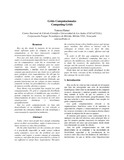Mostrar el registro sencillo del ítem
Grids computacionales.
| dc.rights.license | http://creativecommons.org/licenses/by-nc-sa/3.0/ve/ | |
| dc.contributor.author | Hamar, Vanessa | es_VE |
| dc.date | 2007-07-12 | es_VE |
| dc.date.accessioned | 2007-07-12T09:00:00Z | |
| dc.date.available | 2007-07-12T09:00:00Z | |
| dc.date.created | 2007-07-12 | es_VE |
| dc.date.issued | 2007-07-12T09:00:00Z | es_VE |
| dc.identifier.other | T016300004142/0 | es_VE |
| dc.identifier.uri | http://www.saber.ula.ve/handle/123456789/16724 | |
| dc.description.abstract | Grids computacionales. (Hamar, Vanessa) Resumen Hoy en día, donde la mayoría de las personas tienen suficiente poder de cómputo en su propia computadora, se les hace innecesario compartir recursos para lograr sus propósitos. Pero por otro lado están los científicos, para los cuales es prácticamente imposible hacer ciencia sin el uso de computadoras, cada día se encuentran con problemas cada vez más complejos para los cuales requieren una mayor cantidad de recursos computacionales, y muchas veces la capacidad de computo que puede proveer un cluster no es suficiente para satisfacer estos requerimientos. De allí que los científicos sueñen con equipos con un poder de computo y espacio de almacenamiento ilimitado, que permita interactuar con sus colegas en sitios remotos, compartir la data, los procedimientos y los resultados de manera sencilla, eficiente y segura. Para llenar esta necesidad han surgido los grids computacionales. Un grid es computación distribuida que utiliza un software, el middleware, que coordina y permite compartir los recursos, las aplicaciones, el almacenamiento de datos y los recursos de red, entre organizaciones dinámicas y distribuidas geográficamente. Aun los grids computacionales no han sido desarrollados en su totalidad, en este articulo se presentan los conceptos básicos de esta tecnología y como manejan la seguridad actualmente. Computing grids. (Hamar, Vanessa) Abstract Today, where most people have enough computing power on their own machines, makes it unnecessary to share resource to solve their problems. On the other hand there are the scientists, for whom it is practically impossible to make science without using computers, every day the problems are more complex and require a greater amount of computing resources, and often the power provided by a cluster is not sufficient to satisfy these requirements. Therefore the scientists dream with a limitless power and storage space machine, that allows to interact with its colleagues in remote sites, to share the data, procedures and results in a simple, efficient and safe way. In order to fill this gap computing grids have arisen. Grid is distributed computing that uses a software, the middleware, that coordinates and allows to share the resources, the applications, the data storage and the network resources, between dynamic and geographically distributed organizations. Grids have not yet been totally developed, in this paper the basic concepts of this technology and how they manage the security today. | es_VE |
| dc.format.extent | 80787 | es_VE |
| dc.language.iso | es | es_VE |
| dc.publisher | SABER ULA | es_VE |
| dc.rights | info:eu-repo/semantics/openAccess | |
| dc.title | Grids computacionales. | es_VE |
| dc.title.alternative | Computing grids. | es_VE |
| dc.type | info:eu-repo/semantics/article | |
| dc.description.email | vanessa@ula.ve | es_VE |
| dc.description.tiponivel | Nivel monográfico | es_VE |
| dc.subject.Mots-cles | Ciencias Computacionales | es_VE |
| dc.subject.centroinvestigacion | Centro Nacional de Cálculo Científico (CeCalCULA) | es_VE |
| dc.subject.organizacion | Corporación Parque Tecnológico de Mérida (CPTM) | es_VE |
| dc.subject.tipo | Artículos | es_VE |
Ficheros en el ítem
Este ítem aparece en la(s) siguiente(s) colección(ones)
-
Articulos, Pre-prints (Centro Nacional de Cálculo Científico (CeCalCULA))
Articulos, Pre-prints del Centro Nacional de Cálculo Científico (CeCalCULA)


